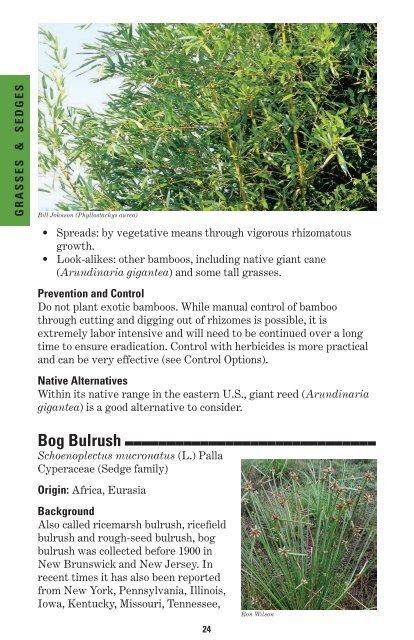Plant Invaders of Mid-Atlantic Natural Areas - National Park Service
Plant Invaders of Mid-Atlantic Natural Areas - National Park Service
Plant Invaders of Mid-Atlantic Natural Areas - National Park Service
Create successful ePaper yourself
Turn your PDF publications into a flip-book with our unique Google optimized e-Paper software.
GRASSES & SEDGES<br />
Bill Johnson (Phyllostachys aurea)<br />
•<br />
•<br />
Spreads: by vegetative means through vigorous rhizomatous<br />
growth.<br />
Look-alikes: other bamboos, including native giant cane<br />
(Arundinaria gigantea) and some tall grasses.<br />
Prevention and Control<br />
Do not plant exotic bamboos. While manual control <strong>of</strong> bamboo<br />
through cutting and digging out <strong>of</strong> rhizomes is possible, it is<br />
extremely labor intensive and will need to be continued over a long<br />
time to ensure eradication. Control with herbicides is more practical<br />
and can be very effective (see Control Options).<br />
Native Alternatives<br />
______________________________<br />
Within its native range in the eastern U.S., giant reed (Arundinaria<br />
gigantea) is a good alternative to consider.<br />
Bog Bulrush<br />
Schoenoplectus mucronatus (L.) Palla<br />
Cyperaceae (Sedge family)<br />
Origin: Africa, Eurasia<br />
Background<br />
Also called ricemarsh bulrush, ricefield<br />
bulrush and rough-seed bulrush, bog<br />
bulrush was collected before 1900 in<br />
New Brunswick and New Jersey. In<br />
recent times it has also been reported<br />
from New York, Pennsylvania, Illinois,<br />
Iowa, Kentucky, Missouri, Tennessee,<br />
24<br />
Ron Wilson

















